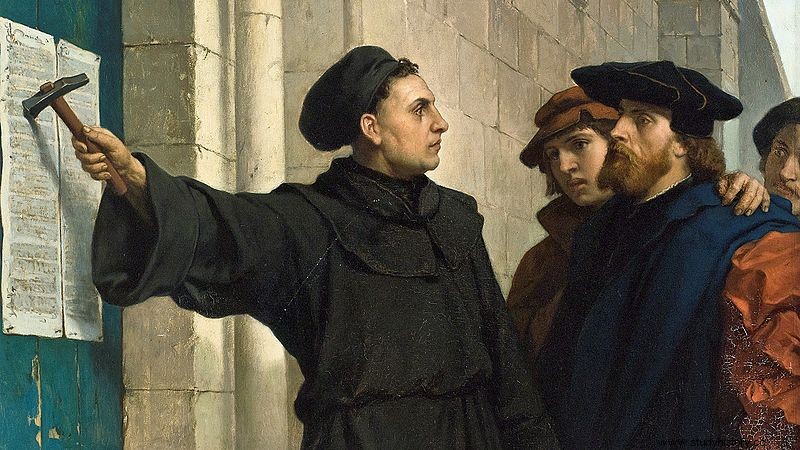- The Roman Church already separated in the XI th century of the Eastern Church. She knew how to impose herself in Europe by successfully fighting many heresies. But since the Great Schism of the West, at the end of the XIV th century, the Church is in full decline.
- Critics abound in the 16 th century:the great properties and wealth of the Church contradict the ideal of poverty in the texts, and it tends to confuse the spiritual and the material, for example by selling indulgences in order to avoid years of purgatory.
- At the same time, Renaissance humanism timidly developed a freer vision of religion and strongly criticized the contradictions of the Church:the weight of Tradition which would almost exceed that of Revelation, and a rich clergy who intrigue in politics.
- Thus, many reforming currents developed within the Church, notably with the writings of John Wyclif or the ultramontanes. But the real split comes with the monk Martin Luther.
October 31, 1517

Characters
Martin Luther
Leon X
Charles V
Procedure
On October 31, 1517, the monk Martin Luther from the city of Wittenberg in Germany published his 95 theses in which he denounced the Church and the practice of indulgences.
More generally, Luther is deeply anticlerical and wishes for a return to the religion of the texts:for him, salvation is individual and no intermediary is necessary in the relationship with God.
His writings caused an immediate stir in Germany, but in 1520 they were condemned by Pope Leo X, and Luther himself was excommunicated.
Luther participates in the organization of the first mass celebrated in the national language and not in Latin. The popular success of the Reformation in Germany eventually spread to the German Empire. In the next ten years, the Reformation reached Germany, Denmark, the French West and many cities in Eastern Europe which broke away little by little from Rome.
In 1530, during the diet of Augsburg, the princes of the Germanic Empire presented a confession to Charles V in which they proclaimed themselves Reformers. Charles V formally condemns Reformism in the name of the Church.
In 1531, Charles V was close to declaring war on the Reformers; these then unite in the League of Smalkald.
In 1534, Henry VIII's England became Anglican.
In 1545, in response to Luther, the Church launched the Counter-Reformation with the Council of Trent.
The Peace of Augsburg of 1555 finally proclaimed religious freedom in the Lutheran states.
Consequences
- Luther's Reformation soon gave rise to diverse currents. There are generally two branches of different inspiration:the Lutherans, then from 1580 the Calvinists.
- Other movements, such as Anglicanism or Anabaptism, may develop through the Reformation.
- It leads everywhere in Europe to religious wars, civil wars or wars between powers.
- The Church launches the Counter-Reformation in opposition to Luther, and finally manages to restructure itself and regain influence in Europe. But Europe is already divided according to a new religious border:the countries of the North with a reformist majority, and the countries of the South with a Catholic majority.
